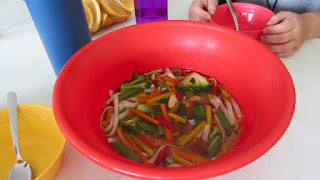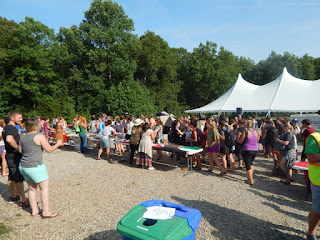On Friday night, my team and I arrived in Ethiopia! It's a very interesting country. Here are some fun facts for you. Enjoy!
- Ethiopia is the only country in Africa that has never been colonized. Italy tried, but the Ethiopians beat them out...twice.
- This is a picture of Ethiopian taxis. A taxi here is called a bajaj. They are a cheap form of transportation. You can fit five passengers and one driver in a bajaj (or six passengers, if one is small and willing to sit on a lap.)
- The currency here is called birr. One dollar equals 21 birr. I recently bought a bottle of water for 9 birr, which equals less than 50 cents. The bills are very colorful and pretty!
- Ethiopia has its own calendar. Today is November 10, 2015, but according to the Ethiopian calendar it is November 1, 2008!
- Ethiopia also has its own way of telling time. I don't understand it entirely, but I know to add 6 hours to whatever time I would normally say, and that is the Ethiopian time. For example, today we are eating lunch at 1:00, but the maids referred to it as 7:00! This is separate from the actual time difference issue. Ethiopia is 8 hours ahead of East Coast time. So, if I wake up at 8:00 am, it is 2:00 according to the Ethiopians, and it is midnight in Pennsylvania!
- The Queen of Sheba, who visited Solomon in the Bible in 1 Kings chapter 10, is a part of Ethiopian legend. According to ancient Ethiopian holy texts, her name was Queen Makeda, and she married Kin Solomon. Also according to the legend, they had a son named Menelik, who founded the Ethiopian kingship.
- The national bread here is called injera. It has a spongy texture and a taste similar to sourdough bread. People use the injera to pick up their other foods rather than using forks and spoons.
- Coffee is a huge part of the culture. Coffee beans were first roasted and made into a drink in Ethiopia. The coffee is very strong and they pour it into very tiny cups. During a coffee ceremony, guests are treated to three rounds of coffee, with each cup becoming progressively weaker. It is considered shameful to not offer coffee to guests.
- Another popular hot drink is shai, the Ethiopian word for tea. The shai is served in tiny cups with heaping spoonfuls of sugar. If you've ever had sweet tea in the South, imagine a hot version of that, and you have shai.
- Religion here is very much a part of the culture. It is very difficult to find an atheist...almost everyone believes in God. About 40% of the population are Orthodox Christians, which is basically a more Catholic version of Catholicism. Orthodox Christians believe in praying to Mary and the Saints, not in praying directly to God. They also put Mary on equal standing with Jesus. About 35% of the population is Muslim, with most of the remaining 25% as Evangelical Christians. They coexist peacefully.
- The language here is called Amharic. Here are some common words and phrases:Selam no – HelloEndatena – How are you? (said to a male)Endatenesh – How are you? (said to a female)Dena nen – I am fine.Exabier Yemeskin – Praise GodAmasaganalu – Thank youChigger yellum – No problemYeekirta – I'm sorry/excuse meEshi – alright, okSeme mano – What is your name? (to a male)Semesh mano – What is your name? (to a female)Semay ___ no – My name is ______Gobez – Good job
That's all for now!
Love,
Miss Jacobs



























































